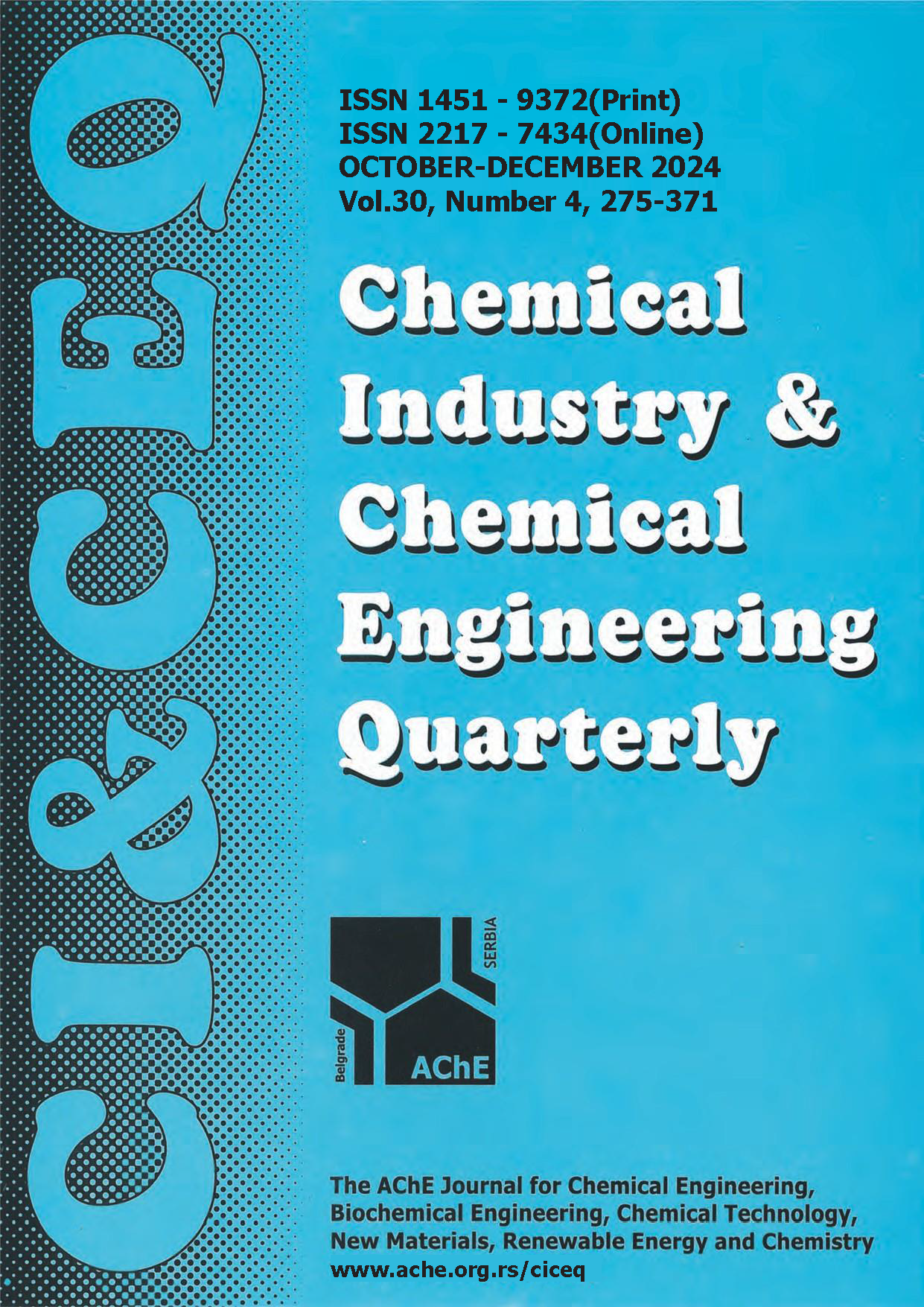BLAST FURNACE SLAG FOR SO2 CAPTURE: OPTIMIZATION AND PREDICTION USING RESPONSE SURFACE METHODOLOGY AND ARTIFICIAL NEURAL NETWORK
Original scientific paper
DOI:
https://doi.org/10.2298/CICEQ230717006KKeywords:
Blast furnace slag, optimization, central composite design, artificial neural network, response surface methodologyAbstract
The main reaction parameters examined were the amount of blast furnace slag, the hydration duration, ammonium acetate concentration, and temperature. The Response surface methodology was employed to quantify their impact on the sorbent's surface area. Using a central composite design, the surface area of the resulting sorbent corresponding to Brunauer- Emmett-Teller (BET) was investigated. The sorbents produced range in surface area from 49.89 to 155.33 m2/g. Additionally, the effectiveness and response prediction capacities of the Response Surface Methodology (RSM) and Artificial Neural Network (ANN) modeling methodologies were investigated. The models were assessed using various statistical metrics, including (MSE) mean squared error, (ARE) average relative errors, the (SSE) sum of squared errors, (HYBRID) Hybrid fractional error function, (SAE) Sum of the absolute errors, (R2)coefficient of determination, and Root means square. According to statistical evidence, the ANN approach surpassed the RSM-CCD model approach. The surface area of the sorbent was shown to be significantly influenced by interactions between variables in addition to all the individual variables examined. The sorbent was made from a material with substantial structural porosity based on SEM. The functional groups were identified using FTIR. The XRF determined the elemental composition of BFS-based sorbents.
References
B.J. Shokri, F. Shafaei, F.D. Ardejani, S. Entezam, Soil Sediment Contam. 32 (2023) 23—40. https://doi.org/10.1080/15320383.2022.2090895.
L. Lerotholi, R.C. Everson, L. Koech, H.W.J.P. Neomagus, H.L. Rutto, D. Branken, B. B. Hattingh, P. Sukdeo, Clean Technol. Environ. Policy 24 (2022) 2011—2060. https://doi.org/10.1007/s10098-022-02308-y.
C. Zheng, K. Li, C. Zhang, D. Deng, Sep. Sci. Technol. 56 (2021) 2499—2506. https://doi.org/10.1080/01496395.2020.1833218.
R.S. Makomere, H.L. Rutto, L. Koech, Arabian J. Sci. Eng. 48 (2022) 8871—8885. https://doi.org/10.1007/s13369-022-07491-0.
A. López-Olvera, S. Pioquinto-García, J. Antonio Zárate, G. Diaz, E. Martínez-Ahumada, J.L. Obeso, V. Martis, D.R. Williams, H.A. Lara-García, C. Leyva, C.V. Soares, G. Maurin, I.A. Ibarra, N.E. Dávila-Guzmán, Fuel 322 (2022) 124213. https://doi.org/10.1016/j.fuel.2022.124213.
X. Li, T. Huhe, T. Zeng, X. Ling, Z. Wang, H. Huang, Y. Chen, Heliyon 8 (2022) 11463. https://doi.org/10.1016/j.heliyon.2022.e11463.
G. Long, C. Yang, X. Yang, T. Zhao, M. Xu, J. Mol. Liq. 302 (2020) 112538. https://doi.org/10.1016/j.molliq.2020.112538.
R. Makomere, H. Rutto, L. Koech, H. Rutto, L. Koech, J. Environ. Sci. Health, Part A 58 (2023) 191—203. https://doi.org/10.1080/10934529.2023.2174334.
D. Gazioglu Ruzgar, S. Altun Kurtoglu, M.F. Fellah, J. Nat. Fibers 19 (2022) 1366—1375. https://doi.org/10.1080/15440478.2020.1764459.
Y. Yu, R. Zhao, J. Chen, H. Yao, Chem. Eng. J. 431 (2022) 134267. https://doi.org/10.1016/j.cej.2021.134267.
M. Banza, H. Rutto, Int. Nano Lett. 12 (2022) 257—272. https://doi.org/10.1007/s40089-022-00369-x.
S. Chellapan, D. Datta, S. Kumar, H. Uslu, Chem. Data Collect. 37 (2022) 100806. https://doi.org/10.1016/j.cdc.2021.100806.
M. Banza, H. Rutto, T. Seodigeng, Soil Sediment Contam. Int. J. 0 (2023) 1—21. https://doi.org/10.1080/15320383.2023.2178384.
C. Mgbemena, S. O. Onyegu, Qeios (2023) 32388. https://doi.org/10.32388/GEGPL7.
A.A. Ayoola, F.K. Hymore, C.A. Omonhinmin, O.C. Olawole, O.S.I. Fayomi, D. Babatunde, O. Fagbiele, Chem. Data Collect. 22 (2019) 100238. https://doi.org/10.1016/j.cdc.2019.100238.
J. Kabuba, M. Banza, Results Eng. 8 (2020) 100189. https://doi.org/10.1016/j.rineng.2020.100189.
M. Banza, H. Rutto, Can. J. Chem. Eng. 101 (2023) 896—908. https://doi.org/10.1002/cjce.24384.
Z. Zhao, K. Patchigolla, Y. Wu, J. Oakey, E.J. Anthony, H. Chen, Fuel Process. Technol. 221 (2021) 106938. https://doi.org/10.1016/j.fuproc.2021.106938.
J.X. Liu, J. Li, W.Q. Tao, Z. Li, Fluid Phase Equilib. 536 (2021) 112963. https://doi.org/10.1016/j.fluid.2021.112963.
J. Lim, J. Kim, Fuel 327 (2022)124986. https://doi.org/10.1016/j.fuel.2022.124986.
J.R. Hanumanthu, G. Ravindiran, R. Subramanian, P. Saravanan, J. Indian Chem. Soc. 98 (2021)100086. https://doi.org/10.1016/j.jics.2021.100086.
D.S.P. Franco, F.A. Duarte, N.P.G. Salau, G.L. Dotto, Chem. Eng. Commun. 206 (2019) 1452—1462. https://doi.org/10.1080/00986445.2019.1566129.
Downloads
Published
Issue
Section
License
Copyright (c) 2023 Itumeleng Kohitlhetse, Suter Kiplagat Evans, Musamba Banza, Robert Makomere

This work is licensed under a Creative Commons Attribution-NonCommercial-NoDerivatives 4.0 International License.
Authors who publish with this journal agree to the following terms:
Authors retain copyright and grant the journal right of first publication with the work simultaneously licensed under a Creative Commons Attribution License that allows others to share the work with an acknowledgement of the work's authorship and initial publication in this journal.
Authors grant to the Publisher the following rights to the manuscript, including any supplemental material, and any parts, extracts or elements thereof:
- the right to reproduce and distribute the Manuscript in printed form, including print-on-demand;
- the right to produce prepublications, reprints, and special editions of the Manuscript;
- the right to translate the Manuscript into other languages;
- the right to reproduce the Manuscript using photomechanical or similar means including, but not limited to photocopy, and the right to distribute these reproductions;
- the right to reproduce and distribute the Manuscript electronically or optically on any and all data carriers or storage media – especially in machine readable/digitalized form on data carriers such as hard drive, CD-Rom, DVD, Blu-ray Disc (BD), Mini-Disk, data tape – and the right to reproduce and distribute the Article via these data carriers;
- the right to store the Manuscript in databases, including online databases, and the right of transmission of the Manuscript in all technical systems and modes;
- the right to make the Manuscript available to the public or to closed user groups on individual demand, for use on monitors or other readers (including e-books), and in printable form for the user, either via the internet, other online services, or via internal or external networks.




